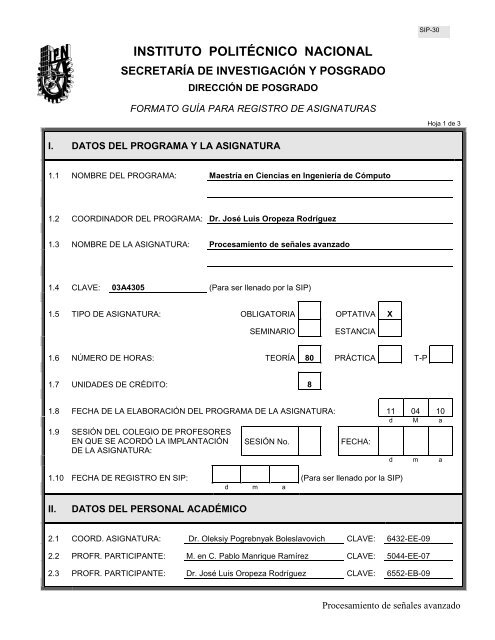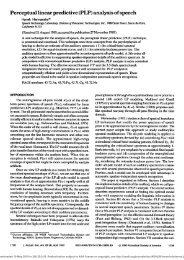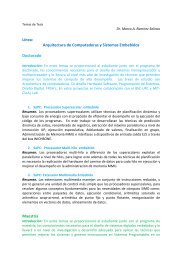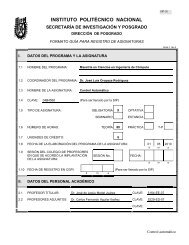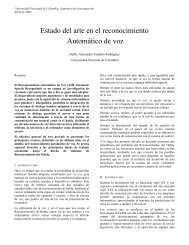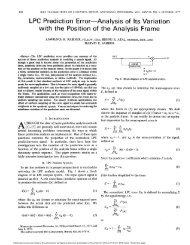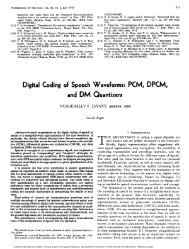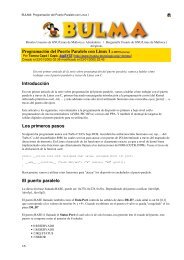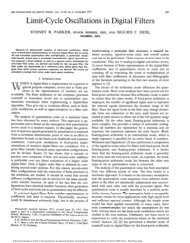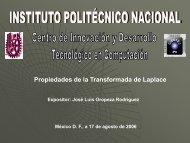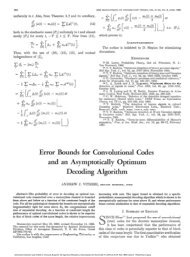Procesamiento de Seales avanzado.pdf - José Luis Oropeza
Procesamiento de Seales avanzado.pdf - José Luis Oropeza
Procesamiento de Seales avanzado.pdf - José Luis Oropeza
You also want an ePaper? Increase the reach of your titles
YUMPU automatically turns print PDFs into web optimized ePapers that Google loves.
Hoja 2 <strong>de</strong> 3III.DESCRIPCIÓN DEL CONTENIDO DEL PROGRAMA DE LA ASIGNATURAIII.1OBJETIVO GENERAL: Que el estudiante conozca y domine los principios <strong>de</strong> filtrado lineal, óptimo yadaptativo, procesamiento <strong>de</strong> tasa múltiple y bancos <strong>de</strong> filtros, procesamiento <strong>de</strong> señalesmultidimensionales, el uso <strong>de</strong> transformada discreta <strong>de</strong> on<strong>de</strong>letas (wavelets).III.2 DESCRIPCIÓN DEL CONTENIDOTEMAS Y SUBTEMASTIEMPO1. INTRODUCCIÓN AL PROCESAMIENTO AVANZADO101.1. Procesos aleatorios. Procesos estocásticos estacionarios.1.2. Ca<strong>de</strong>nas <strong>de</strong> Markov2. ESTIMACIÓN ESPECTRAL182.1 Métodos no-paramétricos2.2 Métodos basados al mo<strong>de</strong>lo3. FILTROS LINEALES ÓPTIMOS.42.1. Filtros <strong>de</strong> Wiener para predicción y filtrado4. PREDICCIÓN LINEAL4.1. Representación <strong>de</strong> innovaciones <strong>de</strong> un proceso aleatorio estacionario.4.2. Predicción lineal hacia <strong>de</strong>lante y hacia atrás4.3. Solución <strong>de</strong> las ecuaciones normales. El algoritmo <strong>de</strong> Levinson-Durbin4.4. Propieda<strong>de</strong>s <strong>de</strong> los filtros <strong>de</strong> error <strong>de</strong> predicción lineal4.5. Filtros en celosía AR y celosía escalonada ARMA5. FILTROS ADAPTATIVOS3.1. El método <strong>de</strong> <strong>de</strong>scen<strong>de</strong>ncia por pasos3.2. El algoritmo <strong>de</strong>l error medio cuadrático LMS3.3. Filtros adaptativos en dominio <strong>de</strong> frecuencia3.4. El método <strong>de</strong> mínimos cuadrados LS3.5. El algoritmo <strong>de</strong> mínimos cuadrados recursivo RLS. Filtros adaptativos <strong>de</strong> raícescuadradas.3.6. Filtros <strong>de</strong> Kalman6. FILTROS ADAPTATIVOS NO-LINEALES BASADOS A REDES NEURONALES6.1. Perceptron multicapa. Algoritmo <strong>de</strong> retropropagación (backpropagation)6.2 Re<strong>de</strong>s neuronales RBF7. TRANSFORMADAS ORTOGONALES7.1. Transformada <strong>de</strong> Karhunen-Loeve. Algoritmos para calcular la transformada discreta<strong>de</strong> coseno.7.2. Transformada discreta <strong>de</strong> on<strong>de</strong>letas.1020108<strong>Procesamiento</strong> <strong>de</strong> señales <strong>avanzado</strong>
Hoja 3 <strong>de</strong> 3III.3 BIBLIOGRAFÍA UTILIZADA EN LA ASIGNATURA1.2.3.4.5Adaptive Filter TheorySimon Haykin – 4 th ed.PRENTICE-HALL., Inc., 2002 ISBN:0-13-090126-1Tratamiento digital <strong>de</strong> señalesProakis, J.G. y Manoakis D.G.PRENTICE HALL Int., Madrid, 1998.Tratamiento <strong>de</strong> señales en tiempo discretoA.Oppenheim, R.Schafer con John R. BuckPrentice-Hall Iberia, Madrid, 2000.Multiresolution Signal Analysis: Transforms, Subbands, WaveletsA.N.Akansu, R.A.HaddadAca<strong>de</strong>mic Press, 1992DSP Applications Using C and the TMS320C6x DSKRulph ChassaingJohn Wiley & Sons, 2002III.4 PROCEDIMIENTOS O INSTRUMENTOS DE EVALUACIÓN A UTILIZAR1. Tres exámenes: 60%2. Tareas y prácticas: 20%3. Proyecto Final: 20%<strong>Procesamiento</strong> <strong>de</strong> señales <strong>avanzado</strong>


